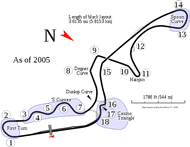The Japanese Grand Prix held at the Suzuka International Racing Course(except for 2007 and 2008)has seen 13 champions being crowned in the 27 times the lights have gone green. Suzuka is one of the few circuits in the racing calendar which has a figure 8 layout. The track has seen only minimal changes to the layout since the track first appeared on the calender in 1987.
The story behind Suzuka is a rather simple one. Soichiro Honda wanted to race in F1. To ensure this happened he wanted to show the western world that Japan could compete with them. In order to accomplish this Honda sent of one of his rather well known and extremely short messages to the Dutch track designer John Hugenholtz. – “I’m building a racetrack. Come to Japan. S. Honda.”
Suzuka is a 5.8 km, 18 turn track which features 4 high speed stretches, 3 very slow turns and 2 major spots for overtaking. Drivers cover a total of 308 km during the full length of a race and can reach speeds of 313 km/h. So lets take a quick look at the track where tomorrow Mark Webber will lead the charge to the 1st turn.
The first two turns
A lap at Suzuka starts with with a fairly long run from Pole position to the first turn which provides the first real overtaking opportunity of the lap. The turn itself itself is a very fast downhill right-hander which features a fairly high entry speed(300km/h). The turn slingshots the drivers towards the 2nd corner. During the course of the first turn the drivers have to shed speed as the track narrows towards the even tighter second turn(165 km/h) which follows. This area usually sees the most number of incidents during the race especially on the start of the lap.
The S-turns
The S-curves at Suzuka start at turn 3 and end at turn 7. The section sees the car climb uphill steadily. From turns 3 to 5 the cars drop speed before picking up speed again for turns 6 and 7. The section can be quite taxing on the car as the exit out of each corner basically is the entrance into the next one. The section is made even more difficult by the fact that the run-off areas are quite minimal and one wrong trick here can kick the driver out of the race. The final corner is the longest and fastest of the lot as the driver heads steeply to the left and uphill through the highly demanding Dunlop curve.
The Degner curves and the HairpinThe Dunlop curves exits into a small straight that leads into the two 90 degree Degner curves. Named after the East German motorcycle rider Ernst Degner who gave Suzuki their first ever motorcycling championship. The first turn’s(turn 8) entrance speed is quite high(200km/h) and it is quite easy for drivers to get it wrong. The next turn(turn 10) is quite slower but is quite a lot tighter and drivers often use the kerb on the exit.
The next turn after the Degnar curves is a very slight kink to the right(turn 10) which then leads into the slowest turn of the race – the hairpin which often provides a chance to overtake. However, to do so you need courage, a rival driver with a lot of common sense as well as heavy dosage of luck.
The Spoon curve
After exiting from the hairpin, the drivers step on the gas as they head towards the Spoon corner. On the way they pass through turn 12, a right hander which is quite easy to handle in the dry but can be quite a headache in the wet. Turn 12 leads the drivers into the Spoon curve which is actually a set of two corners. The first turn is very quick on the way in(180km/h). However the drivers have to cut down on the speed as they reach the much slower and tighter second part of the spoon which has quite low levels of grip.
130R and the Casino Triangle
The drivers exit the Spoon into the back straight and with the cars at full throttle they approach the 130R curve. The 130R is quite frankly the most well known corner of the track and in its heyday was one of the most fearsome and dangerous corners in F1. However, most of that danger has now dissipated due to the amount of down force the cars generate these days. This was quite evident when both the Red Bulls took the corner at full throttle with the DRS flaps wide open during qualifying.
The exit of the 130R leads into a small straight which exits into the final chicane of the lap – The Casino Triangle – a set of 90 degree curves which really slow down the cars before they head into the start/finish straight.
You can experience the lap for yourself below as this year’s pole-sitter goes through a lap of Suzuka in the Red Bull simulator

